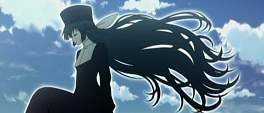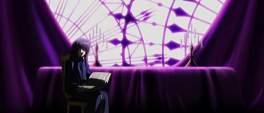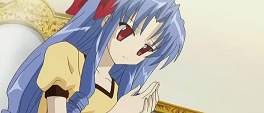



With signature aplomb, SHAFT take up art-duties with ef - a tale of memories and craft a typically stylish and coy introduction to an intriguing and melodramatic series. Long shadows and open skies, stark lines and silhouetted profiles, the art direction obscures the sedate story and mundane characters but the potential for things much greater is too enticing to pass up.
the characters [...] are sometimes infuriatingly obtuse, communicating through enigmatic monologues or understated emotions
ef - a tale of memories pitches itself somewhere in between school drama and supernatural, School Days and Sola; it has the straight faced drama of School Days but more playful, with the fantasy hints of Sola except less blatant. The first episode can best be described as confusing: cutting back and forth between full colour, grayscale, black and white and all points in between seemingly at random then leaping forwards or backwards through time with nary a keystone to right oneself. It conjures up thoughts of Soultaker and the premise being the weirdness rather than coherence; thankfully these thoughts are allayed in the second and third episodes which deftly sculpt the story, rarely allowing itself to be pre-empted by the viewer. It doesn't so much tone-down the oddness as spread it more thinly. The abandon shown for chronology is more telling as certain characters and traits are in one arc and not the other, wordlessly foreshadowing momentous events on the horizon.
Read the rest of this entry




Rental Magica is another series which attempts to be the right-side of the "magic + school children =" equation. Whether the glut of recent shows with this theme is some kind of fallout from the Harry Potter fangasm or perhaps just some kind of coincidence is a question for the future; what is clear is that Rental Magica is a step ahead of its peers by not only being meticulously researched but, more importantly, remarkably engaging and fun.
Rental Magica works so well because it manages to blend a number of historical and mythological concepts into a coherent whole
Beginning with a frantic and kinetic opening sequence on a strangely deserted highway, the series follows a tried-and-tested template of a chaotic first episode, followed by a sedate second and finally settling into a more balanced third. The first is replete with foreshadowing and scattered dialogue one expects from an introduction; it neatly sections out what are no doubt going to be the meat of the series in the form of monster quelling, client interaction and light-hearted school jocularity. None of these individual aspects merit undue focus and the test of the series will be in how well it balances the different facets. After such a riotous initiation, the series obliquely steps back in time in order to flesh out the cycloptic protagonist and his apparent memory loss and relation to the derisive witch of the show. It's an odd move, especially as it at first seems to serve only to reintroduce the tiresome "rich" wench whose saving grace is her UK origin. The third episode continues to explore the enigmatic characters in the central "Astral" team, a format likely to be repeated until a more coherent antagonist can be conjured up.
Read the rest of this entry




Dragonaut's first episode is full of breasts. The second episode is full of dragons. The third episode has breasts and dragons. This is of course entirely unsurprising given the character designer's previous works: Love Hina, Gravion and recently Witchblade; the seminal Stellvia of the Universe seemingly an exception to Makoto Uno's otherwise top-heavy résumé. Abnormally buoyant female appendages aside, Dragonaut's opening episodes are filled with confusing events, terrible CG wyrms and a slow-but-steady introduction to the cold-clinical world the series inhabits.
supposed secret labs and bustling command centres are rendered with a yawn rather than any flair
"Competent" is the best way to describe the series. It bears all the hallmarks of a two season show that isn't prepared to tip its hand at the outset. The hook centres on a trio of creatures that came to earth from outer-space, destroying the protagonist's spacecraft and family along the way. Modi operandi set, time jumps several years into the future when Earth is threatened, people actualise/synchronise/ride mechanical dragons and the once young protagonist now has a barrel full of angst to carry around. Terminology such as "Album", "Dragonaut", "D-Project" and "ISDA" are scattered liberally throughout the dialogue to inject a kind of faux mysticism to the proceedings but fundamentally, nothing is meritorious.
Read the rest of this entry




The first thing one notices about Night Wizard is the gradated hair. The second is that it isn't as laughably comical as its name would suggest it to be. Pitching itself as a fantasy romp with school children, the series' first three episodes focus more on slice of life than slicing of life. It has a kind of wide-eyed innocence and refreshing lack of sexuality which makes it an easy and unintrusive show that is sporadically enjoyable and permanently predictable.
animation is serviceable and never flashy while voice acting is fitting and never memorable
Starting each episode with a blood-red tinged fight scene, it is immediately obvious that neither monster design or fight choreography are strong points; even the character designs feel pre-owned, so it is with some trepidation the series presses on. Beginning with a well trodden prologue of transfer student Ellis Shiho discovering she is in possession of not only an ancient and powerful artefact, but also of magic that may help save the world from a currently ongoing hidden war; it is like slipping into a pair of comfortable trousers. The series does little to deviate from this paradigm, its saving grace is the pace it moves at and the energy each character conveys. The terminal do-gooder attitude of Ellis quickly wears thin but is offset by the unexpected frankness of the shrine-maiden, Kureha Akabane, the clumsy sword-wielder Renji Hiiragi and the devious matriarch Anzelotte. They are novel switch-ups of the usual archetypes but the introduction of the token introvert, Akari Himuro (who totes a Bullet Witch style broom), indicates that this is all that is innovative about the series.
Read the rest of this entry




Calling Goshuushou-sama Ninomiya-kun stunningly unimaginative would be a gross understatement. In three episodes the series has done nothing to endear itself; the only bait it has for its meagre hook is the fan-service which given the ropey art-style is perhaps not bait at all. Three episodes is enough to see exactly where this series is heading: it more or less started at rock bottom and each episode just gives it a new shovel to keep digging.
she constantly attracts members of the opposite gender and elicits buried homosexual tendencies of the same gender
It's fair to say that series like Goshuushou-sama Ninomiya-kun are a dime a dozen, from Green Green to Amaenaideyo, mediocre fan-service is usually not a valid enough premise to warrant sitting through a series, be it 13 or 24 episodes or longer. Series such as Girls Bravo or Ikkitousen more or less perfected the rampant exposure of the female form, the former relying on increasingly racy content while the latter delving into classical Chinese literature; GSNK has neither the energy or the creativity to maintain interest beyond an initial viewing.
Read the rest of this entry



















